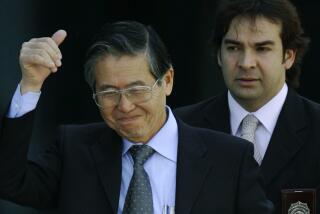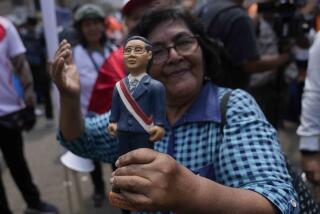Terrorism and Tupac Amaru Rebels in Peru
- Share via
Re “A Game With No Winners,” editorial, Dec. 27: Attacking the lack of perfection in the Tupac Amaru Revolutionary Movement is as futile as trying to support the state terrorism of Peru. Using the word “terrorist” for the Tupac Amaru Revolutionary Movement requires the same word for the Peruvian government. The following differences are significant:
The Peruvian government has the tools to deliver social and distributive justice. The people of Peru have appealed for years to their own government as well as to international organizations and human rights groups. The government of Peru has responded with increasing state terrorism.
The torture institutions and death camps designed by the Peruvian government are new, modern and completely terrorist in structure. One room in each prison is designated for “trials” by hooded individuals who are referred to as judges. The prisoners are also hooded, then tortured and condemned. Three hundred prisoners are currently on an unlimited hunger strike at these institutions of slow death.
Immediate international investigations must be made of the maximum security prison at the Callao Marine Base (constructed in 1993 as a living grave designed to physically and psychologically destroy prisoners) and the maximum security prison at Yanamayo (constructed in 1990 in Puno Province at 13,000-feet elevation), where prisoners slowly die of the cold and a miserable diet.
BLASE BONPANE
Los Angeles
* Your editorial correctly identifies the average Peruvian as the loser in the hostage ordeal. However, the people of Peru have also suffered at the hands of state-sponsored terrorism conducted by security forces with the approval of President Alberto Fujimori.
In 1991, La Cantuta Teachers College, just outside of Lima, was occupied by the Peruvian military. Hooded gunmen kidnapped 10 students and professors from the college. The Fujimori government attempted a cover-up of security force involvement, but a year later, the bodies were discovered, based on a tip by dissident army officers.
The 10 men found guilty of the massacre, members of the “Colina Group,” a clandestine army death squad, were released in 1995, after Fujimori pushed through sweeping amnesty laws absolving any security forces of human rights crimes.
It’s a bit ironic that Fujimori and his military allies should now face a kidnapping crisis on a much larger scale. Let’s hope that the Tupac Amaru rebels are more merciful than were Fujimori’s henchmen.
EDWARD MARKARIAN
Van Nuys
More to Read
Sign up for Essential California
The most important California stories and recommendations in your inbox every morning.
You may occasionally receive promotional content from the Los Angeles Times.










